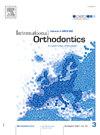Comparison of soft tissue facial changes in patients 7–11 years of age with and without maxillary expansion utilizing CBCTs and 3D facial scans: A preliminary study
IF 1.9
Q2 DENTISTRY, ORAL SURGERY & MEDICINE
引用次数: 0
Abstract
Background
The objectives of this study are to evaluate the effects of maxillary expansion over a period of 12 months on facial soft tissue measurements in children aged 7–11 years with a maxillary transverse deficiency of at least 5 mm or bilateral posterior crossbite, utilizing both CBCTs and 3D facial scans, by comparison to a control group.
Material and methods
Data was collected from 32 patients and consisted of two groups: control and treatment (Hyrax expansion via RME, 1 turn/day). Each patient in each group underwent CBCTs, 3D facial scans and hand-wrist radiographs at two time points: pre-treatment (T0), and after the completion of expansion at post-retention (T1, 12 months). CBCTs were assessed using 3D Slicer software and 3D facial scans were assessed using OrthoInsight 3D software. The soft tissue measurements evaluated included the following: alar width, alar base width, mouth width, philtrum width, nasal tip prominence, nasolabial angle, upper lip to E-line, lower lip to E-line, upper lip height, height of vermillion of upper lip, lower lip height, height of nose, lower facial height and intercanthal width. Statistical analysis included intra- and inter-rater variability, measurement error calculation and MANOVA tests.
Results
From a total of 32 patients with two sets of imaging records, no statistically significant differences were found between the two groups over the one-year observation. However, when comparing the two modalities utilized in this study (CBCT imaging and 3D facial scanning), the correlation was not as optimal for specific outcome variables such as alar base width and intercanthal width, potentially due to anatomic, imaging protocols and patient related factors.
Conclusion
The findings of this study suggest that the children in both groups experienced similar facial soft tissue changes.
利用cbct和3D面部扫描比较7-11岁患者上颌扩张和未上颌扩张的软组织面部变化:一项初步研究
本研究的目的是评估上颌扩张在12个月期间对上颌横向缺陷至少5mm或双侧后牙合的7-11岁儿童面部软组织测量的影响,利用cbct和3D面部扫描与对照组进行比较。材料与方法数据来自32例患者,分为两组:对照组和治疗组(RME扩张Hyrax, 1转/天)。各组患者分别在治疗前(T0)和保留后扩张完成后(T1, 12个月)两个时间点进行cbct、3D面部扫描和腕关节x线片检查。使用3D Slicer软件评估cbct,使用OrthoInsight 3D软件评估3D面部扫描。软组织测量包括:鼻翼宽度、鼻翼底宽度、口宽、中宽、鼻尖突出、鼻唇角、上唇至e线、下唇至e线、上唇高度、上唇朱红色高度、下唇高度、鼻高、下面部高度、鼻间宽度。统计分析包括内部和内部变异、测量误差计算和方差分析。结果32例患者两组影像学记录,两组在1年的观察中无统计学差异。然而,当比较本研究中使用的两种模式(CBCT成像和3D面部扫描)时,可能由于解剖、成像方案和患者相关因素,特定结果变量(如鼻翼基部宽度和鼻间宽度)的相关性并非最佳。结论两组患儿面部软组织变化基本一致。
本文章由计算机程序翻译,如有差异,请以英文原文为准。
求助全文
约1分钟内获得全文
求助全文
来源期刊

International Orthodontics
DENTISTRY, ORAL SURGERY & MEDICINE-
CiteScore
2.50
自引率
13.30%
发文量
71
审稿时长
26 days
期刊介绍:
Une revue de référence dans le domaine de orthodontie et des disciplines frontières Your reference in dentofacial orthopedics International Orthodontics adresse aux orthodontistes, aux dentistes, aux stomatologistes, aux chirurgiens maxillo-faciaux et aux plasticiens de la face, ainsi quà leurs assistant(e)s. International Orthodontics is addressed to orthodontists, dentists, stomatologists, maxillofacial surgeons and facial plastic surgeons, as well as their assistants.
 求助内容:
求助内容: 应助结果提醒方式:
应助结果提醒方式:


